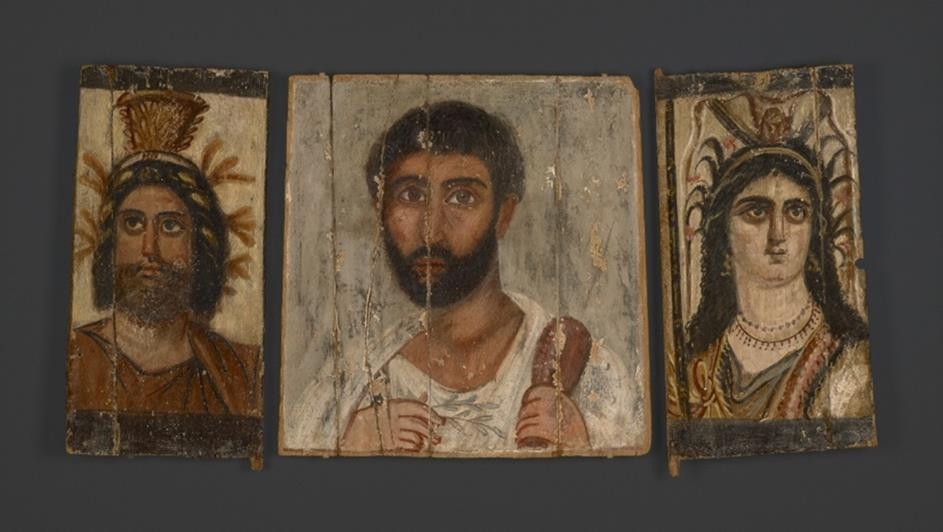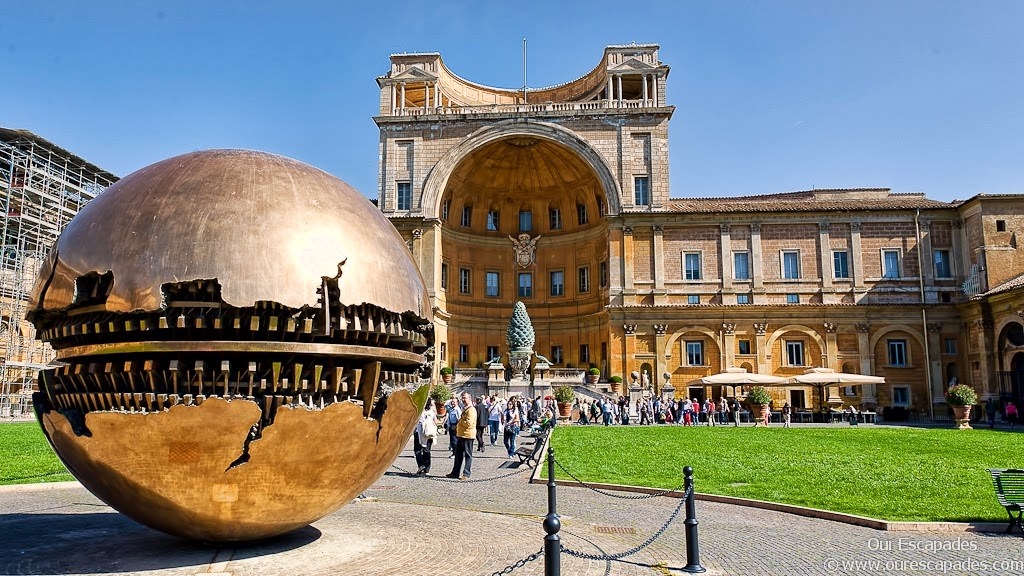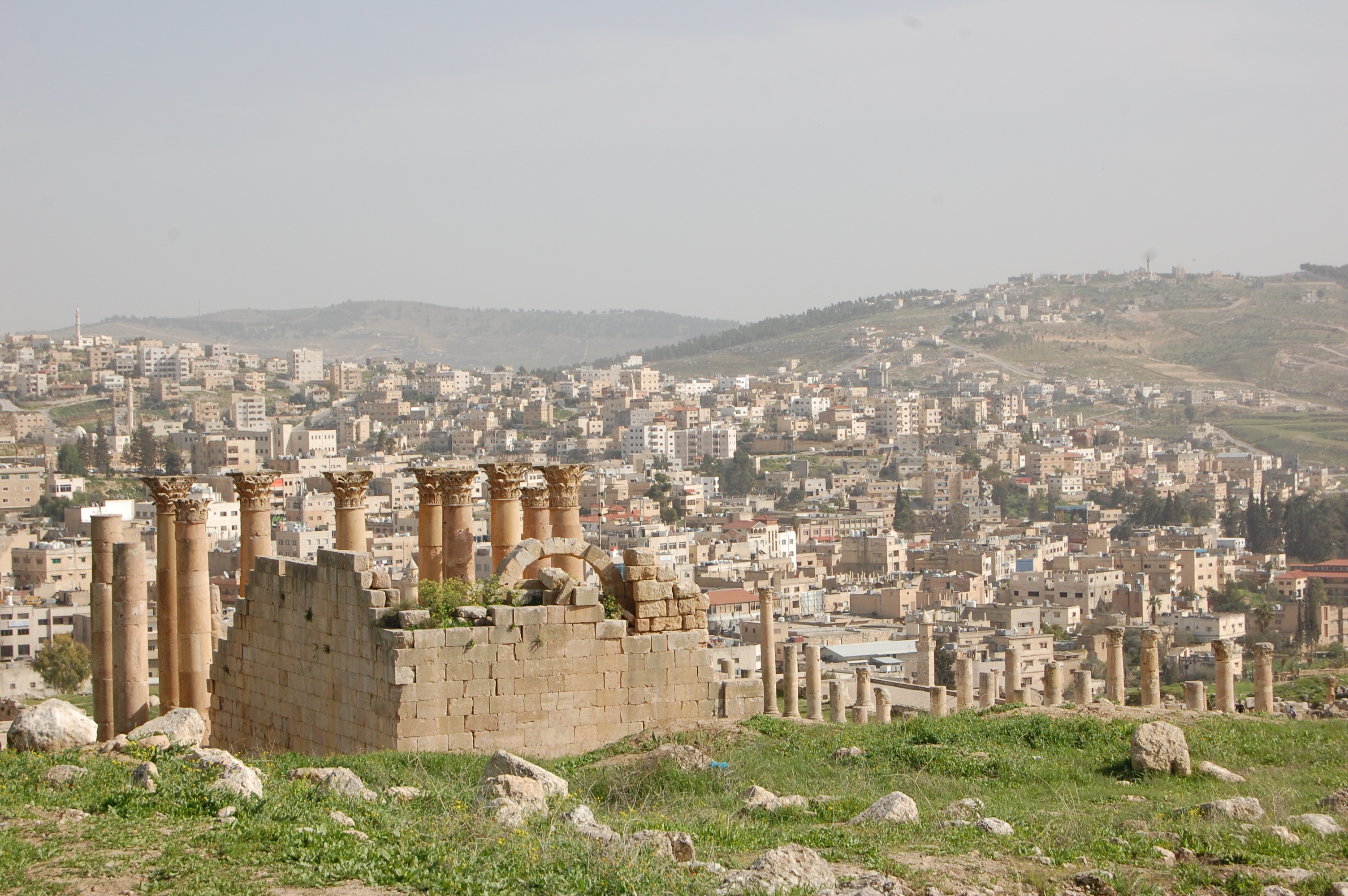Past Events
Interested in Cotsen events? Sign up for our mailing list.Speaker: Dr. Mary Louise Hart, Getty Museum
The last several years have seen extensive research and conservation of the Getty Villa’s collection of Romano-Egyptian panel paintings, which contain a good collection of mummy portraits dating from around AD 50 to about AD 220, the in situ portrait of a red-shroud mummy, and a “group” of Isis and Serapis flanking a square portrait of a mortal man (above). Recently this group – cataloged as a triptych by the museum upon its acquisition in 1974 – underwent an analytical update [published in “A Portrait of a Bearded Man Flanked by Isis and Serapis” published in Icon, Cult and Context (Cotsen, 2016), 79-89]. Past analytical work focused on understanding the materials and authenticity of the panels but had not presented new information about their ancient context or function. More recent organic analysis has revealed a number of different components assuring the ancient integrity and commonality of the panels but has also uncovered evidence of modern restoration in need of clarification. The complex story of origin, restoration, conservation and display inspired the organization of an international exhibition of Romano-Egyptian mummy portraits, shrouds, and associated artifacts (including mummies) for the Getty Villa in the fall of 2019.

Contact Matthew Swanson
Email mswanson@ioa.ucla.edu
Phone
Up to 50% off!
The CIoA Press invites you to celebrate the holidays with a great book!
20% off new titles
50% off slightly damaged books
Bargain Bags! Buy a tote for $10 and fill with all of the bargain books you can fit!
And the chance to win holiday prizes including free books, water bottles, and t-shirts!
CIoA water bottles, t-shirts, postcards, and hats will also be available.
A list of available titles with the sale prices can be downloaded here:
Contact
Email ioapubs@ioa.ucla.edu
Phone
Speaker: Dr. Mark Aldenderfer, UC Merced
From where and when did people first move into and live permanently the High Himalayas? What role did climate change have in the early peopling of the High Himalayas and in subsequent population movements? These questions are explored in three regions of Nepal: Upper Mustang, the Khumbu, and the Rasuwa valley. Archaeological, paleoclimatic, ethnographic, and historical data are combined to provide a comparative assessment of how the inhabitants of these regions coped with climate variability. Insights derived from this research have relevance to the challenges faced by these peoples today in a context of accelerated global warming.
Mark Aldenderfer is Professor of Anthropology in the School of Social Sciences, Humanities, and Arts at the University of California, Merced. His research focuses the comparative analysis of high altitude cultural and biological adaptations from an archaeological perspective. He has worked on the three high elevation plateaus of the planet—Ethiopian, Andean, and Tibetan—over the course of his career and currently works in the High Himalayas of Nepal. He has edited or written more than 10 books, including Montane Foragers (1998), and has published numerous articles and book chapters in journals including Science,PNAS, Journal of Archaeological Science, Latin American Antiquity, and others. He currently serves on the Advisory Board for the Wenner-Gren Foundation and the Executive Board of the American Anthropological Association. He is the editor ofCurrent Anthropology, is an associate editor for anthropology of Science Advances, co-edited Latin American Antiquity, and serves on a number of editorial boards.
Co-sponsored with: Program on Central Asia, Anthropology, Geography,
Contact Matthew Swanson
Email mswanson@ioa.ucla.edu
Phone
Speaker: Alessia Amenta, Vatican Museums
The Vatican Coffin Project gathers an international team of scholars who are divided into three groups with three different areas of expertise: Egyptology, Diagnostic and Conservation. The project has three objectives: the study of the construction and painting techniques of coffins, the identification of workshop patterns and the understanding of the 'packaging' of a coffin. Our work is also aimed at elaborating a protocol for the conservation of the artifacts. The last frontier is the study of paleography of the painted scenes and of the texts. Since new technologies applied to the study of ancient Egyptian coffins undergo constant improvement, this talk will provide an overview of the latest developments.

Contact Matthew Swanson
Email mswanson@ioa.ucla.edu
Phone
Contact
Phone
Speaker: Jared Diamond, UCLA Department of Geography
Part of the Center for Behavior, Evolution, and Culture (BEC) Speaker Series
Contact
Email uclabec@gmail.com
Phone
Due to unforeseen circumstances, this Friday Seminar has been CANCELLED.
Speaker: Dr. Rubina Raja, Aarhus University, Denmark
Since 2011 a Danish-German team has been conducting archaeological fieldwork in ancient Gerasa, Jerash in the Northwest Quarter. The site was one of the famous Decapolis cities mentioned by Pliny and has a rich archaeological record. The large scale excavations of the 1920s and 30s as well as the UNESCO funded international project, Jerash Archaeological Project, which was initiated in the 1980s, are the two largest archaeological undertakings at the site. These projects all focussed on the monumental parts of the city centre. The Danish-German Northwest Quarter Project has taken another approach and has investigated the 4 highest laying hectares within the walled city situated west of the Artemision on a steep hill. This talk will present some of the results from these investigations and show how our understanding of the urban development at the site is improved by looking beyond the main street and its representative monuments.

Contact Matthew Swanson
Email mswanson@ioa.ucla.edu
Phone
Speaker: Thanik Lertcharnrit, Department of Archaeology, Silpakorn University
An event sponsored by the UCLA Center for Southeast Asian Studies and the Cotsen Institute of Archaeology
Contact
Phone
Speaker: Willeke Wendrich, Director of the Cotsen Institute of Archaeology
UCLA has started a close collaboration with the Museo Egizio in Turin, which holds the most important collection of material culture from ancient Egypt after the museum in Cairo. This pizza talk will highlight the research that has been started in the summer of 2016.

Contact Matthew Swanson
Email mswanson@ioa.ucla.edu
Phone
Speaker: Dr. Dorie Reents-Budet, Boston Museum of Fine Arts

This talk employs distributional patterns of pottery, determined by archaeology, ceramic typology, artistic style and nuclear chemistry, to discern Classic Period (250-850 CE) economic interaction spheres among the Maya. The research points to the crucial role played by cotton production in the political economy of the Maya and throughout ancient Mesoamerica, the ceramic distributional patterns coinciding with configurations of alliance noted in other archaeological data.
Contact Matthew Swanson
Email mswanson@ioa.ucla.edu
Phone
- ‹ previous
- 43 of 50
- next ›


